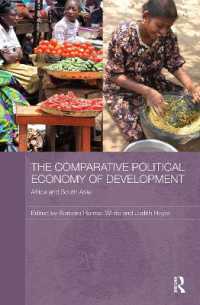Full Description
The Routledge International Handbook of Ethnographic Film and Video is a state-of-the-art book that encompasses the breadth and depth of the field of ethnographic film and video-based research.
With more and more researchers turning to film and video as key elements of their projects, and
as research video production becomes more practical due to technological advances, as well as
the growing acceptance of video in everyday life, this critical book supports a broad and growing
audience. Readers looking to develop the skills necessary to produce meaningful ethnographic
films and videos will find this book to be a comprehensive resource that will help them better
understand and appreciate the unique ways in which film and video can serve as ways of knowing
and as tools of knowledge mobilization. The second edition introduces 18 new chapters, continuing
the book's overall mission of collecting original writings by the world's leading experts in their
respective fields and subfields, while approximately half of the first edition chapters have been
fully updated with coverage of newer references and more contemporary examples and issues.
The contributors synthesize existing literature; introduce the historical and conceptual dimensions
of the field; illustrate innovative methodologies and techniques; survey traditional and new
technologies; reflect on ethics and moral imperatives; outline ways to work with people, objects,
and tools; and shape the future agenda of the field.
The Handbook provides both a comprehensive introduction and up-to-date survey of the field for a vast variety of audiovisual researchers, such as scholars and students in sociology, anthropology, geography, communication and media studies, education, cultural studies, film studies, visual arts, and related social science and humanities. It will appeal to a multidisciplinary and international audience, and features a dynamic, forward-thinking, innovative, and contemporary focus oriented toward the very latest developments in the field, as well as future possibilities.
Contents
1. Ethnographic film and video across the social sciences: An introduction and six injunctions Part 1. Reflecting on the art and science of ethnographic film and video 2. Defining Ethnographic Film 3.Theorizing in/of Ethnographic Film 4. Film Theory and Ethnographic filmmaking 5. Ethnographicness 6. The new art of ethnographic filmmaking 7. Beyond ethnographic representation 8. From ethnographic media to multimodality 9. Ethical fundamentals for ethnographic media making Part 2. Applying and Extending Approaches and Methodologies 10. Ethnomethodological approaches 11. The interactive turn in visual ethnography 12.Visual psychological anthropology 13.Video diaries 14. Feminist and Queer approaches 15. Filming the invisible 16. Autoethnography 17. Participatory filmmaking as a decolonized multimodal collaboration Part 3. Developing Genres and Styles 18. Interactive media 19. Sound matters 20. Documentary hybrids 21.Sensory verité 22. Troubling the ethno in ethnocinema 23. Animation Part 4. Working with Others 24.Filming the Other 25. Collaboration between ethnographers and filmmakers 26. Ethics of engagement 27. Respect, integrity, trust 28. Home, family, and intimate spaces 29. Participation, reception, consent, and refusal 30. Handling conflict and controversy in collaborative filmmaking 31.Collaborative Post-production 32. Collaborative storytelling: a reflexive approach 33. Multispecies filmmaking and research Part 5. Working with Tools and Techniques 34. Filming with (or without) a tripod 35. Mobile video methods and wearable cameras 36. Filmmaking as Musicking 37. Drones 38. 360o Video 39. Screens as Film Locations 40. Athmosphere, rhythm, and scale 41. Found footage and home mode documents 42. Sustainability in ethnographic film and video production Part 6. Distributing and Circulating 43. How to distribute your ethnographic film 44. Circulating ethnographic films in the digital age 45. Reimagining ethnographic film in the age of Instagram Reels and TikTok 46. Ethnographic Film/Video as a Graduate Thesis 47. Ethnographic Film Festivals Part 7. Conclusion 48. Everything you've always wanted to ask an ethnographic filmmaker but never had a chance to 49. The world according to Rouch







